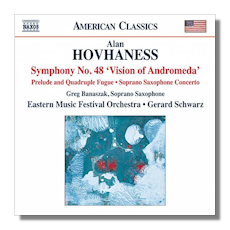
The Internet's Premier Classical Music Source
Related Links
- Hovhaness Reviews
- Latest Reviews
- More Reviews
-
By Composer
-
Collections
DVD & Blu-ray
Books
Concert Reviews
Articles/Interviews
Software
Audio
Search Amazon
Recommended Links
Site News
 CD Review
CD Review
Alan Hovhaness

- Prelude & Quadruple Fugue, Op. 128
- Concerto for Soprano Saxophone & Strings, Op. 344 *
- Symphony #48 "Vision of Andromeda", Op. 355
* Greg Banaszak, soprano saxophone
Eastern Music Festival Orchestra/Gerard Schwarz
Naxos American Classics 8.559755
One view of American composer Alan Hovhaness (1911-2000) is that he was a very facile and highly prolific composer who wrote too much music for his own good, in the end producing relatively few worthwhile compositions. With 434 opus numbers in his output, including 67 symphonies, and hundreds of compositions without opus numbers, it's easy to see that his works moved into competition with themselves: despite how well crafted a particular symphony or concerto or other work might be, it's had to fight for elbow room among its hundreds of siblings. Some would also contend Hovhaness was too much of a chameleon, as his music is often exotic sounding, employing Armenian, Japanese, Indian, Tibetan or other ethnic styles. In addition, many of his compositions employ unusual instrumentation: some of his symphonies are scored for wind ensemble or large band, or use odd percussion instruments or bells. But I doubt that any of these observations are evidence that all or a good portion of his works are second-rate. In fact, one can just as easily make the argument that much of his music is unjustly neglected because of these factors.
One composition that certainly doesn't deserve neglect is Symphony #48, Vision of Andromeda (1982). Inspired by the Andromeda galaxy and astronomy in general, the work has many exotic characteristics: without knowledge of its background, many listeners might associate at least some of the symphony's music with an Eastern European ethnic style. The four movements of this half-hour symphony are very colorfully scored, quite tuneful, rhythmically vital and hauntingly atmospheric. After one listening I was largely won over by the work and wondered why it isn't more popular. Indeed, this is the premiere recording! I can surmise that perhaps Hovhaness is guilty of the sin of being too conservative and approachable at a time when it was more fashionable to be difficult and misunderstood. I can tell you that this work, while mostly light and unpretentious, is better than some of Shostakovich's symphonies and scads of others that have gained a measure of currency in the concert hall. The larger outer movements are mysterious and haunting and feature lively episodes of percussion and bells. The two middle movements are short, very imaginatively scored and feature catchy thematic material. By the way, Hovhaness is well known for his brilliant contrapuntal writing and there are some interesting examples of his counterpoint in this symphony, particularly in the second movement and finale.
Speaking of fugal writing, the Prelude and Quadruple Fugue, Op. 128 (1954), which leads off this disc, is another example of Hovhaness' imaginative contrapuntal skills. It's a mellow but mostly energetic piece lasting seven minutes that in certain passages might remind the listener of some of Vaughan Williams' music. The composer's widow, Hinako Fujihara Hovhaness, who writes the excellent notes for this album, believes this is "the most exciting work he ever wrote."
The Concerto for Soprano Saxophone and Strings, Op. 344 (1980) is an odd work – odd, but interesting, especially if you like the somewhat peculiar sound of the featured instrument. The work is very lyrical and, again, mellow. Cast in three movements and lasting nineteen minutes, it's easy listening not least because of its several attractive melodies. I believe this work might well be more popular in a version for clarinet or oboe, either of which would adapt to the music nicely, I think. Moreover, a rendition for either instrument would likely attract more soloists, more champions. Hinako Fujihara Hovhaness declares that this work "is the most Romantic concerto my husband ever wrote." Since I'm not familiar with his lengthy output I cannot second that opinion, but I will say the concerto is certainly unabashedly Romantic in all three movements.
The performances in these three works are excellent: Greg Banaszak turns in splendid work in the concerto, and Gerard Schwarz, long a champion of American music, leads spirited and totally committed performances. The Eastern Music Festival Orchestra may not be a first rank ensemble but they certainly acquit themselves well in these nicely played efforts. The sound reproduction is clear and well balanced. This is a very interesting disc then of music by Alan Hovhaness, a composer whose stock probably deserves to rise.
Copyright © 2015, Robert Cummings





















